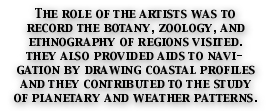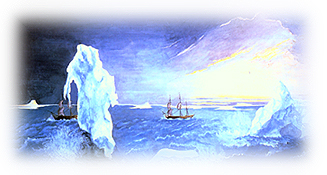| From the sixteenth centure, art was the handmaiden of the exploration of the wider world in the dynamic expansion of Europe. We know, for example, that artists were appointed to Sir Humphrey Gilbert's expedition to Newfoundland in 1583 and Sir Walter Raleigh's to Virginia in 1585. The greatest flourishing of the arts of exploration, however, came with the remarkable series of voyages undertaken by Captain Cook in the late Eighteenth Century. There were artists and draughtsmen on all three of Cook's voyages - across the Pacific (1768 - 71), to the Southern Pacific and Antarctic (1772 - 75), and to the Northern Pacific and the Arctic (1776 - 79) - and they produced several thousand drawings and paintings (both oils and watercolours), most of which still exist. Of those that were lost, some survive through contemporary engravings. Constant reproduction of the art of the expeditions, together with imaginiate reconstructions by later artists, made these voyages the great epic of exploration for many generations. Cook's voyages set a pattern for artists to travel with expeditions and to record their findings - a pattern that was to last until the photographer replaced the artist late in the Nineteenth Century.
This extraordinary outburst of artistic endeavour can be explained by the fact that the voyages were an inseperable part of the scientific revolution of the Eighteenth Century. Both the Royal Society and the Admiralty collaborated to ensure that research in a whole range of subjects was pressed forward by Cook's explorations. The distinguished scientist Sir Joseph Banks, who was present on the first voyage, regarded drawings as more valuable than words in recording and classifying natural history specimens and other peoples, as well as environmental, astronomical, and meteorological phenomena. The role of the artists was to record the botany, zoology, and ethnography of regions visited. They also provided aids to navigation by drawing coastal profiles and they contributed to the study of planetary and weather patterns.
But good artists are generally free agents. Employed to keep an empirical record of all that was seen and discovered, they could not suppress their imaginative and technical faculties. The three principal artists on the voyages - Sydney Parkinson, William Hodges, and John Webber - all far exceeded their briefs. Together with their draughtsmen, they produced more than enough empirical work to satisfy their masters, but they also responded to the excitements of different climates, environments, and peoples to create some remarkable landscapes, portraits, and depictions of events during these great voyages.
Hodges was perhaps the finest of them. He turned what had long been the duty of the seamen in unknown waters - that is, to draw profiles of coasts indicating landmarks with bearings and distances - into a striking art form. He almost certainly painted his major pictures not from sketches, as had previously been the practice, but from direct observation - from the stern windows of Cook's great cabin or ashore in the Pacific. In these remarkable pictures he succeeded in capturing the extraordinary meteorological and light effects of the Antarctic and he experimented with ways of reproducing the nature and intensity of tropical light. In the succeeding voyage, Hodges and Webber produced some sympathetic depictions of the indigenous peoples and animals of the Pacific. Sometimes birds, mammals, or humans were painted as 'specimens' rather than as specific examples, but at other times their subjects were highly individualized, full of character and personality.
Much of the art of the Cook expedition conveys the delight with which artists tried to depict what was startlingly new to them and tried to interpret the peoples of the Pacific in what was Europeans thought of as a sympathetic manner. The work of the artists was, however, an integral part of the extension of European power into the area in ways that were to have very serious consequences for its peoples. Coastal profiles and cartography made it easier for Europeans to return, to settle, and to impose their authority. Even Cook's relatively brief encounters with the coasts of New Zealand, Australia, and the Pacific islands initiated their peoples into market relations and began the spread of European artefacts and even animals. Moreover, the drawings and paintings of the expeditions do not depict their darker side - moments of violence and the spread of sexually transmitted diseases.
Yet the achievements of these artists were outstanding: not only did they make significant contributions to the vast range of scientific materials that emerged from the Cook voyages; they also explored new subjects and fresh techniques in painting, and in so doing influenced major changes in taste that helped to break with the dominant Eighteenth Century conventions - the decorative style know as rococo or the strict adherence to Greek and Roman ideals of neoclassicism. As well as occasionally working in oils, they extended the range of watercolours, demonstrating the great value of this relatively recent medium in offering the opportunity for swift and vivid illustration of unfamiliar scenes. They also helped to create a new school of imperial history painting, particularly when they worked up events (such as Webber's painting of the death of Captain Cook in Hawaii) into oils on their return. Following the pattern set by the Cook voyages, artists continued to serve expeditions until well into the Nineteenth Century. David Livingstone's journeys through Africa were seen as a triumph of exploration to match Cook's voyages. For the first part of the Zambesi expedition of 1858-63, Livingstone too took an artist with him - Thomas Baines, who painted the landscapes and peoples of central Africa.
|


